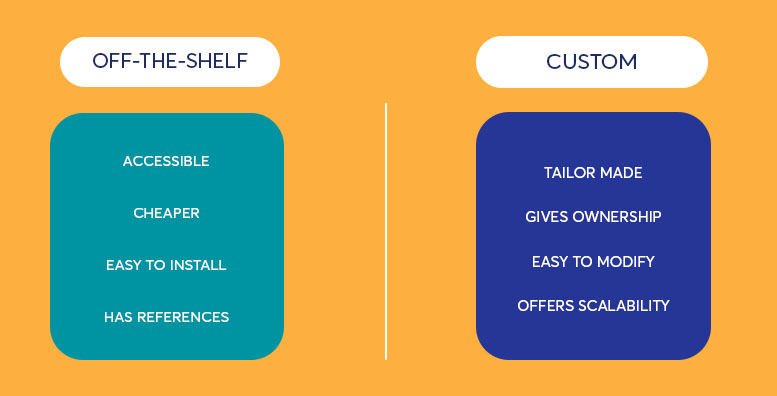Finding the best custom software development partner is the ultimate goal that can make or break your business. You can talk to a number of custom software development companies to make your dream project come true. Having said that, dream projects don’t just happen; they require extensive work, an expert team with years of experience, professional tools, and a proper budget to come into existence.
That’s just the beginning – there are a ton of technicalities that one needs to ponder upon in order to select an appropriate custom software partner. A reliable custom software partner is a one-stop solution to all your requirements. From the budget to the final proposal and flawless execution.
It takes a lot to finalize a custom software partner that fits your approach and ideology well. For the magic to happen, a few factors must be considered. Let’s talk about some of these.
Research: How to narrow down the list?
First, start by creating an extensive list of all the best software development partners in the market, broaden your range globally, and list the best names listed on the web. From that list, narrow down the ones that fit well against your product requirements.
Do a lot of research on the partners that made the shortlist. Find out about their areas of expertise, strengths, work ethics, and methods. Check to see if they can meet all of your software needs, whether it’s web development or making apps for your phone. Take your time and find the best match for yourself before signing them up for your product. Make sure the services they provide align well with your brand image and ideology.
Experience: How good is their portfolio?
Reviewing a potential custom software development partner’s past projects and figuring out how much experience they have is important for more than one reason. Their portfolio can define the extent of their services, deliverables, the scale of projects they tend to board, and whether they are suitable for any future projects.
Picking a company that is familiar with your project and idea is a huge advantage on your behalf since the custom software development company will already be familiar with the challenges that may occur while curating a similar product and will have a definite workaround for them. This ranges from product design to deployment. Look for a software development partner that is an expert with extensive work experience and a proven knowledge base for all sorts of practices that they advertise themselves for.
Communication: Are you being heard?
Seamless communication is integral to finding the best custom software development partner. This is often overlooked while other factors are considered deal-breakers, like pricing, services, and so on. But communication and building a suitable understanding are as crucial in this regard as all the factors mentioned above.
By all means, ensure that there is no communication gap between your company and your custom software development partner. Building an initial understanding of your requirements and demands is necessary. Ensure that you are being heard and that any questions you have been successfully communicated to the software development team by the project manager so that they can be addressed as soon as possible.
Location: What works best for you?
When looking for a software development partner for your business, location can be one of the most important things to consider. It is also one of the prime factors that one needs to have an eye out for. The base location of the company you have selected can be one of the following: onshore, offshore, or nearshore.
Onshore
Any company that is available in your hometown or country will be labeled as an “onshore” company. Not only are they in your time zone, but there is also a 100% possibility of a one-on-one meeting whenever required, providing room for establishing an understanding and smooth communication.
One downside to this is that onshore companies are usually extremely costly. So one must allot a hefty budget to secure one of the local software development companies.
Offshore
This one is self-explanatory; offshore companies have their bases in foreign countries. Their companies may be located on international grounds, but they offer services across the globe at affordable rates, which is why businesses go for an offshore custom software development company.
Despite the cheaper cost and good service, a major disadvantage is different time zones and a one-on-one communication gap due to that. Online meetings can be set up, but when time zones clash, one or the other has to suffer by giving in time after work hours to schedule meetings.
Nearshore
When you hire a custom software development company from a country close to your own region or a direct neighbor, that’s called “nearshoring.” Hiring a nearshore company is a win-win situation because it is not only cost-effective but also in a similar time zone, which will make scheduling meetings super easy for both parties without having to work outside business hours.
Pricing: How much is too much?
The prices that a certain software development partner offers signify the service they provide. However, this does not mean that companies with a hefty price tag are offering the best services; certain unnecessary expenses are involved in that regard. Meanwhile, do not be tempted by a low-cost package from any company, as they lack various technical skills and tools required to create a top-notch software application.
Some of the best custom software development companies will cost you money, but it will be absolutely justified based on the services, dedication, and ideology that they implement while executing the product.
If you can not afford the best companies, wait until you can. Rushing to create a subpar product from a cheap software development company can result in a larger loss. In this case, waiting is the best option – save up enough to be able to afford the best.
Tools and Technologies: Are they using the best?
In the long run, top-notch software development companies that use the best and most emerging technologies for scalable and reliable software applications tend to be the best choice. It’s important to have the most up-to-date tools for making software because it needs to be modern and flexible, and come with the best tools and plug-ins for the best user experience and interface.
Moreover, the company must create transparency between themselves and their clients by giving them access to their project management tools. Transparency ensures trust and keeps the client in the loop regarding the progress of their product and the technology used to create it from scratch..
In the End – Choosing the Best Custom Software Development Partner
After thorough research and examination, it eventually comes down to selecting reliable custom software development partners. It may be a complex task, but a well-researched selection will benefit in the long run. Take your time and consider all the major factors mentioned above, and then come up with a decision.
FAQs for custom software and over-the-shelf software
Research! That’s the only factor that can help you find the best custom software development company. After getting a list of all the potential companies, narrow down your research to what fits best in your budget, how experienced are they, what is their work ethics and how advanced are their tools and technologies used to create a masterpiece.
A good software development partner has the best tools to work with, is amongst the cream of the IT industry along with having the best reviews and a top-notch portfolio for review along with a great score from their previous clients. Moreover, they should be able to provide the services efficiently that they claim, and that is required by the client as well.







